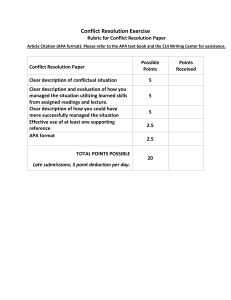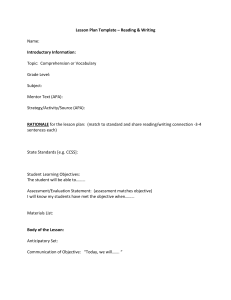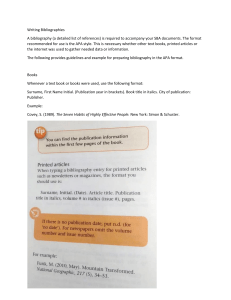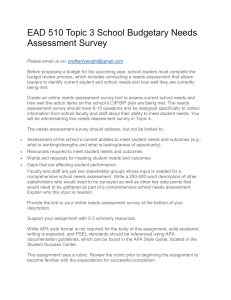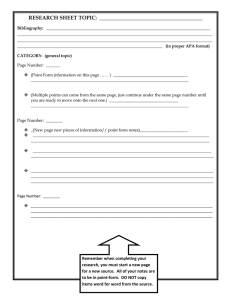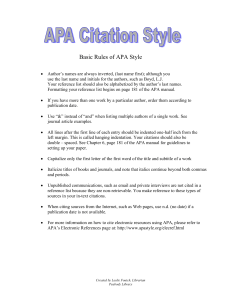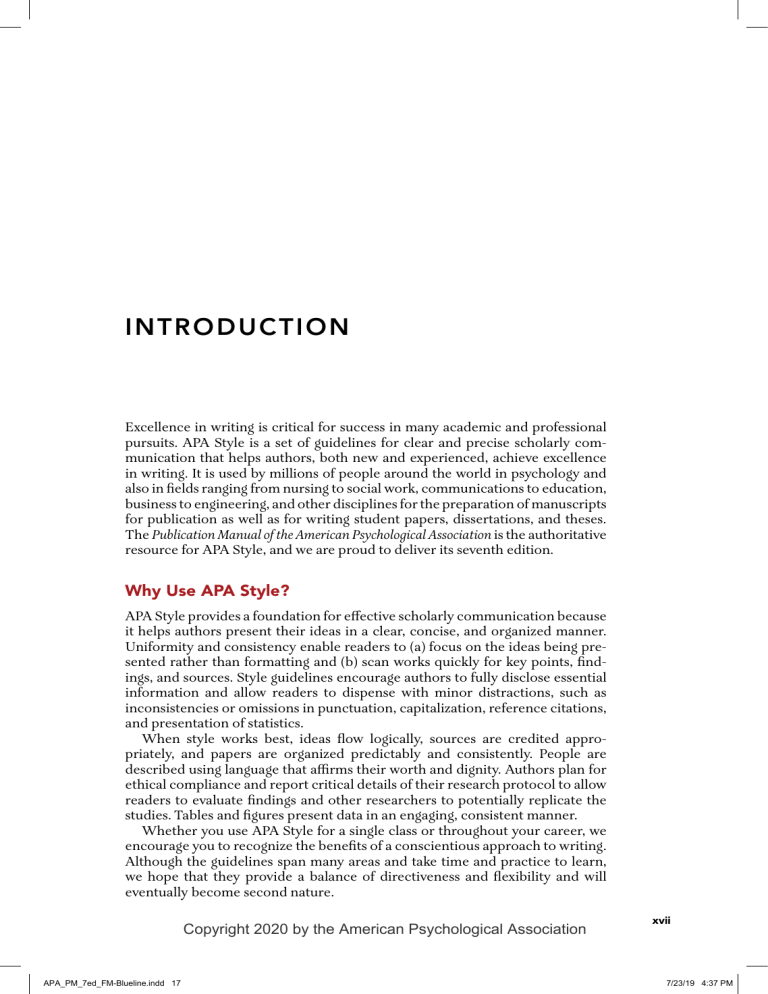
INTR O DUCT I O N Excellence in writing is critical for success in many academic and professional pursuits. APA Style is a set of guidelines for clear and precise scholarly communication that helps authors, both new and experienced, achieve excellence in writing. It is used by millions of people around the world in psychology and also in fields ranging from nursing to social work, communications to education, business to engineering, and other disciplines for the preparation of manuscripts for publication as well as for writing student papers, dissertations, and theses. The Publication Manual of the American Psychological Association is the authoritative resource for APA Style, and we are proud to deliver its seventh edition. Why Use APA Style? APA Style provides a foundation for effective scholarly communication because it helps authors present their ideas in a clear, concise, and organized manner. Uniformity and consistency enable readers to (a) focus on the ideas being presented rather than formatting and (b) scan works quickly for key points, findings, and sources. Style guidelines encourage authors to fully disclose essential information and allow readers to dispense with minor distractions, such as inconsistencies or omissions in punctuation, capitalization, reference citations, and presentation of statistics. When style works best, ideas flow logically, sources are credited appropriately, and papers are organized predictably and consistently. People are described using language that affirms their worth and dignity. Authors plan for ethical compliance and report critical details of their research protocol to allow readers to evaluate findings and other researchers to potentially replicate the studies. Tables and figures present data in an engaging, consistent manner. Whether you use APA Style for a single class or throughout your career, we encourage you to recognize the benefits of a conscientious approach to writing. Although the guidelines span many areas and take time and practice to learn, we hope that they provide a balance of directiveness and flexibility and will eventually become second nature. Copyright 2020 by the American Psychological Association APA_PM_7ed_FM-Blueline.indd 17 xvii 7/23/19 4:37 PM xviii • INTRODUCTION APA Style for Students The Publication Manual has long been an authoritative source for scholarly writing, and this edition provides more targeted guidance and support for students. All students, no matter what career they pursue, can benefit from mastering scholarly writing as a way to develop their critical thinking skills and hone the precision and clarity of their communication. Most guidelines in the Publication Manual can be applied to both student papers and professional manuscripts. The manual also has elements specifically designed for students, including a student title page; guidance on citing classroom or intranet sources; and descriptions of common types of student papers such as annotated bibliographies, response papers, and dissertations and theses. Journal article reporting standards (JARS) are intended primarily for authors seeking publication but may be helpful for students completing advanced research projects. Utility and Accessibility We have created the seventh edition of the Publication Manual with the practical needs of users in mind. Within chapters, content is organized using numbered sections to help users quickly locate answers to their questions. This ease of navigability and depth of content mean that the manual can be used as both a reference work and a textbook on scholarly writing. This edition promotes accessibility for everyone, including users with disabilities. In consultation with accessibility experts, we ensured that the guidelines support users who read and write works in APA Style through a variety of modalities, including screen readers and other assistive technologies. For example, we present a streamlined format for in-text citations intended to reduce the burden of both writing and reading them. We provide guidance on how to use adequate contrast in figures to meet Web Content Accessibility Guidelines (Web Accessibility Initiative, 2018). We also support the use of a variety of fonts and default settings in common word-processing programs, meaning that users need to make fewer adjustments to their systems to be ready to write in APA Style. Above all, our aim is to support the many ways in which people communicate. We encourage authors to be conscientious and respectful toward both the people about whom they are writing and the readers who will benefit from their work. What’s New in the Seventh Edition? Brief descriptions of new and updated content are provided next on a chapterby-chapter basis. For a more comprehensive overview of content changes, see the APA Style website (https://apastyle.apa.org). Chapter 1: Scholarly Writing and Publishing Principles Chapter 1 addresses types of papers and ethical compliance. New guidance addresses quantitative, qualitative, and mixed methods arti- cles as well as student papers, dissertations, and theses. Copyright 2020 by the American Psychological Association APA_PM_7ed_FM-Blueline.indd 18 7/23/19 4:37 PM INTRODUCTION • xix Information on planning for and ensuring ethical compliance reflects best practices. Guidance on data sharing, including in qualitative research, reflects open practice standards. Chapter 2: Paper Elements and Format Chapter 2 is designed to help novice users of APA Style select, format, and organize paper elements. The title page is updated for professionals, and a new student title page is provided. For all papers, the byline and affiliation format on the title page aligns with publishing standards. The author note includes more information, such as ORCID iDs, disclosure of conflicts of interest or lack thereof, and study registration information. The running head format has been simplified for professional authors and is not required for students. Font specifications are more flexible to address the need for accessibility. An updated heading format for Levels 3, 4, and 5 improves readability and assists authors who use the heading-styles feature of their word-processing program. Two new sample papers are provided: a professional paper and a student paper, with labels to show how specific elements appear when implemented. Chapter 3: Journal Article Reporting Standards Chapter 3 orients users to journal article reporting standards (JARS) and includes tables outlining standards for reporting quantitative, qualitative, and mixed methods research. JARS for quantitative research has been significantly expanded and updated (see Appelbaum et al., 2018; Cooper, 2018). The updated JARS now cover qualitative and mixed methods research (see Levitt, 2019; Levitt et al., 2018). Chapter 4: Writing Style and Grammar Chapter 4 provides guidance on writing style and grammar. The singular “they” is endorsed, consistent with inclusive usage. More detailed guidance helps writers avoid anthropomorphism. Chapter 5: Bias-Free Language Guidelines Chapter 5 presents bias-free language guidelines to encourage authors to write about people with inclusivity and respect. Existing guidance on age, disability, gender, racial and ethnic identity, and sexual orientation has been updated to reflect best practices. Copyright 2020 by the American Psychological Association APA_PM_7ed_FM-Blueline.indd 19 7/23/19 4:37 PM xx • INTRODUCTION New guidance is provided on participation in research, socioeconomic sta- tus, and intersectionality. Chapter 6: Mechanics of Style Chapter 6 covers the mechanics of style, including punctuation, capitalization, abbreviations, numbers, and statistics in text. Updated guidance answers a common question: Use one space after a period at the end of a sentence, unless an instructor or publisher requests otherwise. Formatting of linguistic examples has changed; quotation marks are now used around examples, rather than italics, to promote accessibility. Expanded guidance is provided on the capitalization of proper nouns, job titles, diseases and disorders, and more. Guidelines for the presentation of abbreviations address common questions, such as how to include a citation with an abbreviation. Guidelines for the presentation of numbers have been updated to be consis- tent throughout a work (e.g., there is no longer an exception for presenting numbers in an abstract). New guidance is given on how to write gene and protein names. Updated guidelines allow greater flexibility for lettered, numbered, and bul- leted lists. Chapter 7: Tables and Figures Chapter 7 presents guidance on creating tables and figures. More than 40 new sample tables and figures are presented, in dedicated sec- tions, covering a variety of research types and topics. The presentation of tables and figures in text is more flexible (either after the reference list on separate pages or embedded in the text). Formatting of tables and figures is parallel, including consistent styles for numbers, titles, and notes. The accessible use of color in figures is addressed. Chapter 8: Works Credited in the Text Chapter 8 addresses appropriate levels of citation as well as plagiarism, selfplagiarism, and other unethical writing practices. In-text citations have been simplified; all in-text citations for works with three or more authors are shortened to the name of the first author plus “et al.” (except where this would create ambiguity). New guidance is provided on how to cite recorded or unrecorded Traditional Knowledge and Oral Traditions of Indigenous Peoples. Examples of paraphrasing demonstrate how to achieve clear attribution without overcitation. New guidance is provided on how to format quotations from research partic- ipants. Copyright 2020 by the American Psychological Association APA_PM_7ed_FM-Blueline.indd 20 7/23/19 4:37 PM INTRODUCTION • xxi Chapter 9: Reference List Chapter 9 examines the four elements of a reference list entry (author, date, title, and source). The number of authors included in a reference entry has changed; up to 20 authors are now included before names are omitted with an ellipsis. The presentation of digital object identifiers (DOIs) and URLs has been stan- dardized. Both are presented as hyperlinks; the label “DOI:” is no longer used, and the words “Retrieved from” are used only when a retrieval date is also needed. Updated guidance explains when to include DOIs and URLs for works retrieved from most academic research databases as well as from proprietary databases such as ERIC or UpToDate. New formatting guidance is provided for annotated bibliographies. Chapter 10: Reference Examples Chapter 10 provides more than 100 examples of APA Style references, each with accompanying parenthetical and narrative in-text citations. Templates are provided for every reference category. References are streamlined; for example, journal article references always in- clude the issue number, and book references now omit the publisher location. Audiovisual materials receive expanded coverage, with new examples for YouTube videos, PowerPoint slides and lecture notes, TED Talks, and more. Social media, webpages, and websites are addressed in new categories. For consistency and ease of formatting, blogs and other online platforms that publish articles are part of the periodicals category. Chapter 11: Legal References Chapter 11 presents expanded and updated legal reference examples. Guidelines from The Bluebook: A Uniform System of Citation continue to be the foundation for APA Style legal references, with some modifications. New, relevant legal reference examples are provided (e.g., the Every Student Succeeds Act). Chapter 12: Publication Process Chapter 12 provides guidance on the publication process. New content helps early career researchers adapt a dissertation or thesis into a journal article or articles, select a journal for publication, avoid predatory or deceptive publishers, and navigate journal submission. Improved guidance on the journal publication process reflects current processes and policies authors need to be aware of when preparing a manuscript for submission. New guidance addresses how authors can share and promote their work following publication. Copyright 2020 by the American Psychological Association APA_PM_7ed_FM-Blueline.indd 21 7/23/19 4:37 PM xxii • INTRODUCTION APA Style Online The APA Style website (https://apastyle.apa.org) is the premier and authoritative online destination for APA Style. In addition to numerous free resources and instructional aids, it contains supplemental content that is referred to throughout the manual, including additional reference examples, sample papers, and guidance on using color effectively and accessibly in figures. The JARS website (https://apastyle.apa.org/jars) contains the full repository of information about journal article reporting standards for a wide range of research designs; it is freely available to complement the orienting information in Chapter 3. The APA Style blog (https://apastyle.apa.org/blog) and related social media accounts will continue to answer questions about and share insights into APA Style with the publication of the seventh edition, providing authoritative content from members of the APA Style team. Academic Writer (https://digitallearning.apa.org/academic-writer) is APA’s cloud-based tool for teaching and learning effective writing. Developed by the creators of APA Style, this product helps both student and professional authors compose research papers and master the application of seventh-edition APA Style. Notes to Users The Publication Manual refers to numerous products and services that are not affiliated with the American Psychological Association but that our readers may encounter or use during the process of research, writing, and publication. The trademarks referenced in the Publication Manual are the property of their respective owners. The inclusion of non-APA products is for reference only and should not be construed as an endorsement of or affiliation between APA and the owners of these products and their respective brands. Finally, some eagle-eyed users have asked why every aspect of APA Style is not applied throughout this manual. The manual is a published work, whereas the guidelines for APA Style are meant to be applied to manuscripts being submitted for publication or to student papers. Considerations for published works such as this book (e.g., typesetting, line spacing, length, fonts, use of color, margins) differ from those of draft manuscripts or student papers and thus necessitate deviations from APA Style formatting. Also, in this manual—in which we are writing about writing—it is often necessary to distinguish between explanatory text and examples through the use of font, color, and other design elements. Wherever possible, however, we have endeavored to demonstrate APA Style while writing about it and to present the information in a way that is accessible for our many users around the world. Copyright 2020 by the American Psychological Association APA_PM_7ed_FM-Blueline.indd 22 7/23/19 4:37 PM
